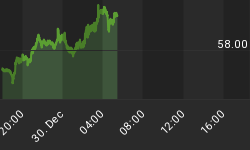Plunging ISM manufacturing data in the U.S. forebodes a GDP growth rate of just about 1%. And crumbling global PMI manufacturing data indicates worldwide growth is retreating to just 2%. There is a deepening recession in the EU (17) countries, while emerging market economic growth has collapsed. It isn't much of a surprise to learn that central banks in China, Britain, Europe and America have indicated that more money printing is just around the corner.
In fact, we have recently witnessed the People's Bank of China cut their one-year lending rate by 31 bps to 6%. The European Central Bank cut rates 25 bps, to .75% and dropped their deposit rate to 0%. And the Bank of England restarted their bond purchase program just two months after ending the previous program, which indicates the central bank will buy another 50 billion pounds of government debt. Global central banks' love affair with counterfeiting is now without question and beyond precedent. But one has to wonder how effective more money printing will be when interest rates are already at or near rock bottom.
A central bank's stock and trade is to engage in a legalized form of counterfeiting. But counterfeiting doesn't do a very good job of encouraging businesses into expanding the amount of goods and services available for purchase; especially if the process has been well advertised. Bernanke believes in embracing Glasnost at the Fed. He wants everyone to know and understand the motives behind every action at the central bank. However, if everyone is aware that a massive round of counterfeiting is underway, it makes no sense for the economy to hire new workers or increase productivity. It is much easier to simply raise prices. If the newly created money isn't backed by anything and does not represent any increase in goods and services in the economy, rising prices will result.
If I show up at the grocery store to buy gallons of milk with counterfeit money and I tell the manager that the bills came from my printing press located in my home's basement, he will call the police...not call his suppliers to have them ramp up the milk production supply chain. However, it is illegal not to accept a central bank's money. Therefore, prices increase because the market has lost faith in the currency's purchasing power. Unfortunately, the Fed is working very hard to destroy the global confidence in holding the world's reserve currency. But it now seems Bernanke isn't alone in his quest to hold the title of counterfeiter in chief.
However, when a central bank prints money there are two sides to the equation. On the positive side, money printing, when done on the margin, lowers interest rates and reduces borrowing costs in the economy. That provides debt service relief to borrowers and can encourage people to take on even more debt--which isn't such a good idea but it can boost growth in the short term. On the negative side of the equation, savers are punished and rising prices erode the purchasing power of the middle and lower classes. That's because they see the newly created money last...if they do at all. When an economy is in a balance sheet recession--as the developed world finds itself today--the economy must deleverage and will not take on much more debt regardless of how low the cost of money falls. If interest rates are already at zero percent, there can be no further relief on debt service payments that can be attained by more money printing.
It is clear that governments need to allow the deflationary deleveraging process to finally run its course, rather than continue to artificially prop up the economy by expanding public debt and having the central bank buy it all up.
More QE at that point only exacerbates the negative side of the ledger by putting further pressure on the middle class. Real GDP will contract as inflation takes off. That is what I expect to occur if the ECB and Fed recommence monetizing public debt, just like we saw the BOE do recently. Asset prices will rise but the economy will sink further into the stagflationary morass.
















